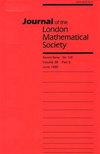求助PDF
{"title":"权重1在Γ 0(N) $\\mathbf {\\Gamma _0(N)}$上的Jacobi形式","authors":"Jialin Li, Haowu Wang","doi":"10.1112/jlms.70306","DOIUrl":null,"url":null,"abstract":"<p>Let <span></span><math>\n <semantics>\n <mrow>\n <msub>\n <mi>J</mi>\n <mrow>\n <mn>1</mn>\n <mo>,</mo>\n <mi>m</mi>\n </mrow>\n </msub>\n <mrow>\n <mo>(</mo>\n <mi>N</mi>\n <mo>)</mo>\n </mrow>\n </mrow>\n <annotation>$J_{1,m}(N)$</annotation>\n </semantics></math> be the vector space of Jacobi forms of weight one and index <span></span><math>\n <semantics>\n <mi>m</mi>\n <annotation>$m$</annotation>\n </semantics></math> on <span></span><math>\n <semantics>\n <mrow>\n <msub>\n <mi>Γ</mi>\n <mn>0</mn>\n </msub>\n <mrow>\n <mo>(</mo>\n <mi>N</mi>\n <mo>)</mo>\n </mrow>\n </mrow>\n <annotation>$\\Gamma _0(N)$</annotation>\n </semantics></math>. In 1985, Skoruppa proved that <span></span><math>\n <semantics>\n <mrow>\n <msub>\n <mi>J</mi>\n <mrow>\n <mn>1</mn>\n <mo>,</mo>\n <mi>m</mi>\n </mrow>\n </msub>\n <mrow>\n <mo>(</mo>\n <mn>1</mn>\n <mo>)</mo>\n </mrow>\n <mo>=</mo>\n <mn>0</mn>\n </mrow>\n <annotation>$J_{1,m}(1)=0$</annotation>\n </semantics></math> for all <span></span><math>\n <semantics>\n <mi>m</mi>\n <annotation>$m$</annotation>\n </semantics></math>. In 2007, Ibukiyama and Skoruppa proved that <span></span><math>\n <semantics>\n <mrow>\n <msub>\n <mi>J</mi>\n <mrow>\n <mn>1</mn>\n <mo>,</mo>\n <mi>m</mi>\n </mrow>\n </msub>\n <mrow>\n <mo>(</mo>\n <mi>N</mi>\n <mo>)</mo>\n </mrow>\n <mo>=</mo>\n <mn>0</mn>\n </mrow>\n <annotation>$J_{1,m}(N)=0$</annotation>\n </semantics></math> for all <span></span><math>\n <semantics>\n <mi>m</mi>\n <annotation>$m$</annotation>\n </semantics></math> and all squarefree <span></span><math>\n <semantics>\n <mi>N</mi>\n <annotation>$N$</annotation>\n </semantics></math> with <span></span><math>\n <semantics>\n <mrow>\n <mi>gcd</mi>\n <mo>(</mo>\n <mi>m</mi>\n <mo>,</mo>\n <mi>N</mi>\n <mo>)</mo>\n <mo>=</mo>\n <mn>1</mn>\n </mrow>\n <annotation>$\\mathrm{gcd}(m,N)=1$</annotation>\n </semantics></math>. This paper aims to extend their results. We determine all levels <span></span><math>\n <semantics>\n <mi>N</mi>\n <annotation>$N$</annotation>\n </semantics></math> separately, such that <span></span><math>\n <semantics>\n <mrow>\n <msub>\n <mi>J</mi>\n <mrow>\n <mn>1</mn>\n <mo>,</mo>\n <mi>m</mi>\n </mrow>\n </msub>\n <mrow>\n <mo>(</mo>\n <mi>N</mi>\n <mo>)</mo>\n </mrow>\n <mo>=</mo>\n <mn>0</mn>\n </mrow>\n <annotation>$J_{1,m}(N)=0$</annotation>\n </semantics></math> for all <span></span><math>\n <semantics>\n <mi>m</mi>\n <annotation>$m$</annotation>\n </semantics></math>; or <span></span><math>\n <semantics>\n <mrow>\n <msub>\n <mi>J</mi>\n <mrow>\n <mn>1</mn>\n <mo>,</mo>\n <mi>m</mi>\n </mrow>\n </msub>\n <mrow>\n <mo>(</mo>\n <mi>N</mi>\n <mo>)</mo>\n </mrow>\n <mo>=</mo>\n <mn>0</mn>\n </mrow>\n <annotation>$J_{1,m}(N)=0$</annotation>\n </semantics></math> for all <span></span><math>\n <semantics>\n <mi>m</mi>\n <annotation>$m$</annotation>\n </semantics></math> with <span></span><math>\n <semantics>\n <mrow>\n <mi>gcd</mi>\n <mo>(</mo>\n <mi>m</mi>\n <mo>,</mo>\n <mi>N</mi>\n <mo>)</mo>\n <mo>=</mo>\n <mn>1</mn>\n </mrow>\n <annotation>$\\mathrm{gcd}(m,N)=1$</annotation>\n </semantics></math>. We also establish explicit dimension formulae of <span></span><math>\n <semantics>\n <mrow>\n <msub>\n <mi>J</mi>\n <mrow>\n <mn>1</mn>\n <mo>,</mo>\n <mi>m</mi>\n </mrow>\n </msub>\n <mrow>\n <mo>(</mo>\n <mi>N</mi>\n <mo>)</mo>\n </mrow>\n </mrow>\n <annotation>$J_{1,m}(N)$</annotation>\n </semantics></math> when <span></span><math>\n <semantics>\n <mi>m</mi>\n <annotation>$m$</annotation>\n </semantics></math> and <span></span><math>\n <semantics>\n <mi>N</mi>\n <annotation>$N$</annotation>\n </semantics></math> are relatively prime or <span></span><math>\n <semantics>\n <mi>m</mi>\n <annotation>$m$</annotation>\n </semantics></math> is squarefree. These results are obtained by refining Skoruppa's method and analyzing local invariants of Weil representations. As applications, we prove the vanishing of Siegel modular forms of degree 2 and weight 1 in some cases.</p>","PeriodicalId":49989,"journal":{"name":"Journal of the London Mathematical Society-Second Series","volume":"112 4","pages":""},"PeriodicalIF":1.2000,"publicationDate":"2025-09-29","publicationTypes":"Journal Article","fieldsOfStudy":null,"isOpenAccess":false,"openAccessPdf":"","citationCount":"0","resultStr":"{\"title\":\"Jacobi forms of weight 1 on \\n \\n \\n \\n Γ\\n 0\\n \\n \\n (\\n N\\n )\\n \\n \\n $\\\\mathbf {\\\\Gamma _0(N)}$\",\"authors\":\"Jialin Li, Haowu Wang\",\"doi\":\"10.1112/jlms.70306\",\"DOIUrl\":null,\"url\":null,\"abstract\":\"<p>Let <span></span><math>\\n <semantics>\\n <mrow>\\n <msub>\\n <mi>J</mi>\\n <mrow>\\n <mn>1</mn>\\n <mo>,</mo>\\n <mi>m</mi>\\n </mrow>\\n </msub>\\n <mrow>\\n <mo>(</mo>\\n <mi>N</mi>\\n <mo>)</mo>\\n </mrow>\\n </mrow>\\n <annotation>$J_{1,m}(N)$</annotation>\\n </semantics></math> be the vector space of Jacobi forms of weight one and index <span></span><math>\\n <semantics>\\n <mi>m</mi>\\n <annotation>$m$</annotation>\\n </semantics></math> on <span></span><math>\\n <semantics>\\n <mrow>\\n <msub>\\n <mi>Γ</mi>\\n <mn>0</mn>\\n </msub>\\n <mrow>\\n <mo>(</mo>\\n <mi>N</mi>\\n <mo>)</mo>\\n </mrow>\\n </mrow>\\n <annotation>$\\\\Gamma _0(N)$</annotation>\\n </semantics></math>. In 1985, Skoruppa proved that <span></span><math>\\n <semantics>\\n <mrow>\\n <msub>\\n <mi>J</mi>\\n <mrow>\\n <mn>1</mn>\\n <mo>,</mo>\\n <mi>m</mi>\\n </mrow>\\n </msub>\\n <mrow>\\n <mo>(</mo>\\n <mn>1</mn>\\n <mo>)</mo>\\n </mrow>\\n <mo>=</mo>\\n <mn>0</mn>\\n </mrow>\\n <annotation>$J_{1,m}(1)=0$</annotation>\\n </semantics></math> for all <span></span><math>\\n <semantics>\\n <mi>m</mi>\\n <annotation>$m$</annotation>\\n </semantics></math>. In 2007, Ibukiyama and Skoruppa proved that <span></span><math>\\n <semantics>\\n <mrow>\\n <msub>\\n <mi>J</mi>\\n <mrow>\\n <mn>1</mn>\\n <mo>,</mo>\\n <mi>m</mi>\\n </mrow>\\n </msub>\\n <mrow>\\n <mo>(</mo>\\n <mi>N</mi>\\n <mo>)</mo>\\n </mrow>\\n <mo>=</mo>\\n <mn>0</mn>\\n </mrow>\\n <annotation>$J_{1,m}(N)=0$</annotation>\\n </semantics></math> for all <span></span><math>\\n <semantics>\\n <mi>m</mi>\\n <annotation>$m$</annotation>\\n </semantics></math> and all squarefree <span></span><math>\\n <semantics>\\n <mi>N</mi>\\n <annotation>$N$</annotation>\\n </semantics></math> with <span></span><math>\\n <semantics>\\n <mrow>\\n <mi>gcd</mi>\\n <mo>(</mo>\\n <mi>m</mi>\\n <mo>,</mo>\\n <mi>N</mi>\\n <mo>)</mo>\\n <mo>=</mo>\\n <mn>1</mn>\\n </mrow>\\n <annotation>$\\\\mathrm{gcd}(m,N)=1$</annotation>\\n </semantics></math>. This paper aims to extend their results. We determine all levels <span></span><math>\\n <semantics>\\n <mi>N</mi>\\n <annotation>$N$</annotation>\\n </semantics></math> separately, such that <span></span><math>\\n <semantics>\\n <mrow>\\n <msub>\\n <mi>J</mi>\\n <mrow>\\n <mn>1</mn>\\n <mo>,</mo>\\n <mi>m</mi>\\n </mrow>\\n </msub>\\n <mrow>\\n <mo>(</mo>\\n <mi>N</mi>\\n <mo>)</mo>\\n </mrow>\\n <mo>=</mo>\\n <mn>0</mn>\\n </mrow>\\n <annotation>$J_{1,m}(N)=0$</annotation>\\n </semantics></math> for all <span></span><math>\\n <semantics>\\n <mi>m</mi>\\n <annotation>$m$</annotation>\\n </semantics></math>; or <span></span><math>\\n <semantics>\\n <mrow>\\n <msub>\\n <mi>J</mi>\\n <mrow>\\n <mn>1</mn>\\n <mo>,</mo>\\n <mi>m</mi>\\n </mrow>\\n </msub>\\n <mrow>\\n <mo>(</mo>\\n <mi>N</mi>\\n <mo>)</mo>\\n </mrow>\\n <mo>=</mo>\\n <mn>0</mn>\\n </mrow>\\n <annotation>$J_{1,m}(N)=0$</annotation>\\n </semantics></math> for all <span></span><math>\\n <semantics>\\n <mi>m</mi>\\n <annotation>$m$</annotation>\\n </semantics></math> with <span></span><math>\\n <semantics>\\n <mrow>\\n <mi>gcd</mi>\\n <mo>(</mo>\\n <mi>m</mi>\\n <mo>,</mo>\\n <mi>N</mi>\\n <mo>)</mo>\\n <mo>=</mo>\\n <mn>1</mn>\\n </mrow>\\n <annotation>$\\\\mathrm{gcd}(m,N)=1$</annotation>\\n </semantics></math>. We also establish explicit dimension formulae of <span></span><math>\\n <semantics>\\n <mrow>\\n <msub>\\n <mi>J</mi>\\n <mrow>\\n <mn>1</mn>\\n <mo>,</mo>\\n <mi>m</mi>\\n </mrow>\\n </msub>\\n <mrow>\\n <mo>(</mo>\\n <mi>N</mi>\\n <mo>)</mo>\\n </mrow>\\n </mrow>\\n <annotation>$J_{1,m}(N)$</annotation>\\n </semantics></math> when <span></span><math>\\n <semantics>\\n <mi>m</mi>\\n <annotation>$m$</annotation>\\n </semantics></math> and <span></span><math>\\n <semantics>\\n <mi>N</mi>\\n <annotation>$N$</annotation>\\n </semantics></math> are relatively prime or <span></span><math>\\n <semantics>\\n <mi>m</mi>\\n <annotation>$m$</annotation>\\n </semantics></math> is squarefree. These results are obtained by refining Skoruppa's method and analyzing local invariants of Weil representations. As applications, we prove the vanishing of Siegel modular forms of degree 2 and weight 1 in some cases.</p>\",\"PeriodicalId\":49989,\"journal\":{\"name\":\"Journal of the London Mathematical Society-Second Series\",\"volume\":\"112 4\",\"pages\":\"\"},\"PeriodicalIF\":1.2000,\"publicationDate\":\"2025-09-29\",\"publicationTypes\":\"Journal Article\",\"fieldsOfStudy\":null,\"isOpenAccess\":false,\"openAccessPdf\":\"\",\"citationCount\":\"0\",\"resultStr\":null,\"platform\":\"Semanticscholar\",\"paperid\":null,\"PeriodicalName\":\"Journal of the London Mathematical Society-Second Series\",\"FirstCategoryId\":\"100\",\"ListUrlMain\":\"https://londmathsoc.onlinelibrary.wiley.com/doi/10.1112/jlms.70306\",\"RegionNum\":2,\"RegionCategory\":\"数学\",\"ArticlePicture\":[],\"TitleCN\":null,\"AbstractTextCN\":null,\"PMCID\":null,\"EPubDate\":\"\",\"PubModel\":\"\",\"JCR\":\"Q1\",\"JCRName\":\"MATHEMATICS\",\"Score\":null,\"Total\":0}","platform":"Semanticscholar","paperid":null,"PeriodicalName":"Journal of the London Mathematical Society-Second Series","FirstCategoryId":"100","ListUrlMain":"https://londmathsoc.onlinelibrary.wiley.com/doi/10.1112/jlms.70306","RegionNum":2,"RegionCategory":"数学","ArticlePicture":[],"TitleCN":null,"AbstractTextCN":null,"PMCID":null,"EPubDate":"","PubModel":"","JCR":"Q1","JCRName":"MATHEMATICS","Score":null,"Total":0}
引用次数: 0
引用
批量引用


 求助内容:
求助内容: 应助结果提醒方式:
应助结果提醒方式:


